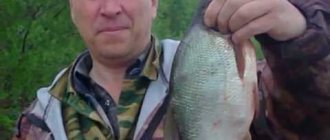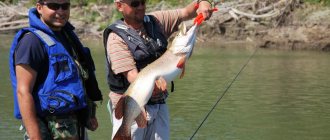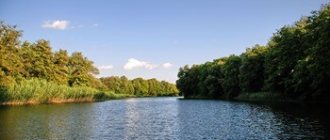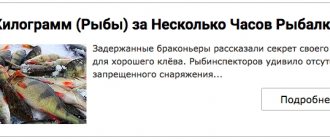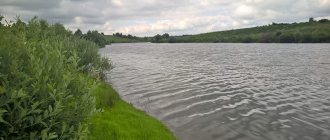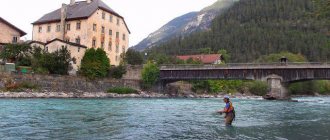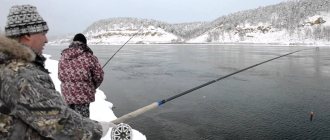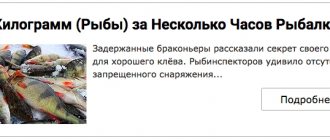Reservoirs of Sakhalin
The largest island of Russia has not only an extensive sea coast, but also a huge number of inland bodies of water - rivers, streams, lakes.
Rivers
There are 61,178 rivers of different lengths and depths flowing on the island. We will describe the largest and most extensive among them below.
Poronai
This is the longest river of the island, with a length of 350 km. Originating on the Nabilsky Ridge, it flows through the central part of Sakhalin through the territory of three large districts (Tymovsky, Smirnykhovsky and Poronaisky), flowing into the Terpeniya Bay of the Sea of Okhotsk. At the same time, not far from the mouth, the watercourse divides into 2 branches, forming a rather large and heavily swamped island.
Poronai is a river very rich in fish stocks. It is home to many valuable salmon species such as taimen, masu salmon, pink salmon, chum salmon, and kunja.
The name of the Poronai River means “big river” in the language of the indigenous inhabitants of Sakhalin, the Ainu.
Tym
Tym is the second longest and deepest river on the island. It is 330 km long and has a drainage basin of 7,850 km2. The source of the river is at the highest point of the island - Mount Lopatina (1609 meters above sea level). Flowing along the eastern coast of Sakhalin, it flows into the Nyisky Bay of the Sea of Okhotsk near the village of Nogliki, dividing into two large branches (channels). The river is home to a lot of Salmon, and its numerous small and fast-flowing tributaries contain their natural spawning grounds.
Naiba
Naiba is the third longest river in Sakhalin (it has a length of 119 km and a river basin area of 1,660 km2). The river originates in the Western Sakhalin Mountains, on the Shrenka Ridge and, flowing through the territory of the Dolinsky urban district, flows into the Sea of Okhotsk. There are several villages and the fairly large city of Dolinsk on the river.
The ichthyofauna of the Naiba is as rich and varied as that of the other two major rivers of the island.
Also, large natural watercourses with a length of more than 100 km and a drainage basin area of more than 1,000 km2 include rivers such as Lyutoga, Val, Nysh, Uglegorka, Langeri, Rukutama, Nabil. Most of them flow into the Sea of Okhotsk, and only the Rukutama River feeds the large Neva Lake.
Popular Reservoirs of Sakhalin | Which River is the Largest?
Water sources in the region are especially popular among fishermen, and the catch format often becomes industrial.
However, you can find a lot of cozy places where you can calmly go fishing with a fishing rod or go to the bottom in a boat. The main thing is to study in detail the information about the reservoirs where you are going.
The choice of bait, fishing rod and other fishing equipment will depend on this.
The Pronai River is the largest in the Sakhalin Region
This river is considered the largest on the island; it flows into the Sea of Okhotsk, therefore it is rich in Salmon species, which often come here depending on the Season.
Tym River | Rich in Fish
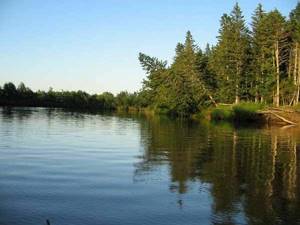
3 ways to improve your fish bite!
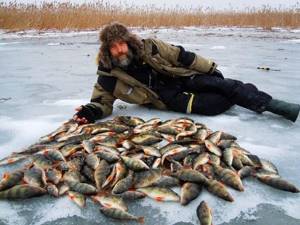
Over 15 years of active fishing, I have found many ways to improve the bite, and here are the most effective:
1. Bite activator . This pheromone additive attracts fish most strongly in cold and warm water. The Fish Hungry bite activator has proven itself to be excellent - Read more…
2. Tackle with increased sensitivity . You should first familiarize yourself with the features of using a particular type.
3. Pheromone baits . They attract the attention of fish, stimulate hunger and cause a schooling reflex, which allows you to collect a lot of fish in one place.
You can get the rest of the secrets of successful fishing for free by reading my other materials on the site.
3 ways to improve your fish bite!
Over 15 years of active fishing, I have found many ways to improve the bite, and here are the most effective:
1. Bite activator . This pheromone additive attracts fish most strongly in cold and warm water. The Fish Hungry bite activator has proven itself to be excellent - Read more…
2. Tackle with increased sensitivity . You should first familiarize yourself with the features of using a particular type.
3. Pheromone baits . They attract the attention of fish, stimulate hunger and cause a schooling reflex, which allows you to collect a lot of fish in one place.
You can get the rest of the secrets of successful fishing for free by reading my other materials on the site.
This river is a little shorter in length, however, it is also rich in various fish compositions.
In general, there are a lot of rivers on the islands, their number is over 65 thousand, so it is not surprising that fishing in this region is so in demand.
Fishing on Sakhalin in Winter | What kind of fish are you catching?
Winter fishing on Sakhalin begins in late autumn and ends in mid-spring.
The most successful bite at this time of year is observed at:
Taimen;
Rudds.
You can also catch:
Pike;
Smelt;
And Flounder.
Sea Sakhalin Fishing
This type of leisure is especially intriguing. At times when there is a lull in the rivers, avid fishermen move to offshore areas to catch catfish and other species.
At the beginning of the Summer Season, salmon and trout are actively biting, since at this time the fish go into the sea.
Crab Fishing on Sakhalin
This type of “hunting” begins from the moment the north wind begins to blow on the shores at the end of autumn. It is very difficult to see a live crab; even more difficult is to catch it in natural conditions.
Catching this delicacy is classified as an “Exotic” type of fishing, so you should carefully prepare in advance.
Fishing Spots on the Map | Add a Place
What kind of fish are there?
Sakhalin is famous not only for the rich ichthyofauna of the rivers and lakes of the island part, but also for the large species diversity of fish living in the coastal waters of the Sea of Okhotsk and the Sea of Japan.
In inland waters
More than 60 species of fish live in the rivers and lakes of the island. The most common among them are representatives of the following families:
- Salmon - brown trout, chum salmon, pink salmon, sockeye salmon, coho salmon, Sakhalin taimen, malma, kunja, Chinook salmon, Amur grayling, Amur whitefish, lenok;
- Flounder – star and striped flounder;
- Cyprinids – silver crucian carp, Sakhalin rudd, Amur ide, bream, asp, carp
- Pike – pike;
- Perch - perch;
- Smelts – smallmouth smelt, catfish smelt;
- Cod - burbot.
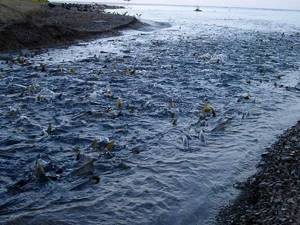
Chum salmon goes to spawn
In the sea coastal area
In the waters surrounding the island, the Sea of Okhotsk and the Sea of Japan are home to more than 600 different species of fish. The main objects of commercial and recreational fishing are the following:
- herring;
- flounder;
- pink salmon;
- chum salmon;
- pollock;
- saury;
- mackerel;
- cod;
- navaga;
- smelt;
- greenling;
- halibut.
Fishing on the island
They fish on Sakhalin all year round. During the open water season, anglers go to narrow but fish-rich taiga rivers and lakes. In winter, the most catchy ones are large lakes covered with thick and durable ice (fast ice), sea lagoons, channels, and estuarine areas of rivers flowing into the sea.
Summer fishing
The most interesting and catchy summer fishing in the rivers of the island is in the second half of summer (late July-August), as well as the beginning of autumn (September). It is at this time that Pacific salmon enter the large rivers of Sakhalin and their tributaries to spawn - chum salmon, pink salmon, Chinook salmon, sockeye salmon, brown trout, masu salmon, salmon, etc. They are caught in areas with a hard pebble bottom, medium or weak current. The most catchy gear for salmon fishing is a hard spinning rod 2.4-2.7 m long with a weight of 10 to 40 g or a fly fishing class 5-6. It is less common to catch salmon going to spawn on a leader float tackle.
Also at this time, large bream, silver crucian carp, and Sakhalin carp begin to actively catch large bream, silver carp, and Sakhalin carp in lakes and river backwaters. These types of fish are caught using a float rod or donkey.
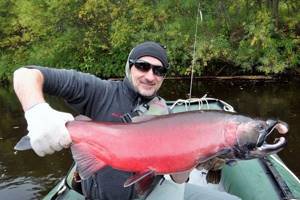
Fishing for Pacific salmon entering rivers to spawn is most interesting and productive using spinning rods
Before entering rivers, Pacific salmon often fatten in sea bays located near the mouths. Here they are actively caught using large spoons and heavy silicone baits.
Winter fishing
Winter fishing on Sakhalin begins in early December and ends in mid-April (in the south of the island) - early May (in the northern regions). At the same time, small and medium taiga lakes are covered with ice first, then larger freshwater bodies of water and sea bays. The estuarine areas of fast taiga rivers are the last to freeze.
At the beginning of winter, the main object of recreational fishing is such a small, but very tasty fried and dried fish as smallmouth (small smelt). There are 3 main types of this fish found on Sakhalin - ordinary, sea and Japanese. Common smallmouth, of medium size, are caught at the beginning of winter on such large lakes as Izmenchivoe, Tunaicha, Bolshoye Busse, Lebyazhye, and in the estuary areas of large rivers flowing into sea lagoons.
The smallmouth, distinguished by its large size, is caught in numerous lagoons, as well as in the Promyslovaya channel, which connects Lake Nevskoe with the sea area. The smallest Japanese smelt among smallmouths is caught in the sea bays of the north-eastern part of the island, in the Vavai lakes, Tunaich, and the Ainakskoe lagoon lake. In addition to smallmouth in Tuinach, the herring and star flounder that winter here also bite very well on the first ice.
Also, at the beginning of the winter period, when inclement and frosty weather sets in, burbot begins to actively feed. They catch it in lake and river pits on postavushi (under-ice girders) using chicken skin, a piece of dead fish, and small smelt as bait.
With the onset of severe frosts and the strengthening of the ice shell on the island’s reservoirs and coastal lagoons, the fish bite does not deteriorate. Thus, already at the end of January - beginning of February, active post-spawning nibbles of navaga and bison begin in the mouths of rivers flowing into the sea, as well as in large sea bays. At the same time, Sakhalin rudd is caught very well in deep river wintering holes.
At the end of winter, predatory fish become active in the rivers - the kunja begin to bite, and in the southern regions, spawned char and southern dollyfish begin to actively feed.
No less interesting and productive is winter fishing in the reservoirs located in the depths of the island. So, on taiga lakes, large perch and ruff bite well on a jig all winter. A very large pike is caught on the girders
To catch smallmouth smelt, saffron cod, and bison, they use such a simple but quite productive tackle as a “swinger” - a carbon fiber fishing rod up to 1 m long with a flexible whip, with a small reel or bobbin reel on which a 20-30 meter supply of monofilament fishing line is wound cross section 0.1-0.12 mm. Homemade or store-bought narrow spinners with a length of 6-7 to 15-16 mm are used as bait for this gear.
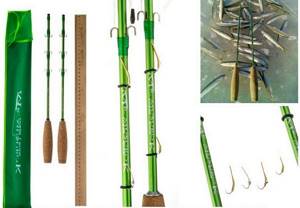
“Makhalka” is the most productive tackle for ice fishing for smallmouth smelt
On a note! The most expensive component of fly fishing gear is not the carbon fiber rod or monofilament line, but small spoons. The high cost of this small bait is due to the fact that precious metals - gold, silver - are used in its manufacture. Thanks to the use of such materials, baits retain a shine that attracts fish for a very long time and do not become cloudy from contact with salt water.
The technique of fishing with this tackle with a good bite is very simple - the fisherman, sitting on a chair or box between two holes drilled at a short distance, lowers the fly rig (a fishing line with an attached spoon) into them, after which, performing short and smooth lifts with fishing rods, he very often throws out ice silvery nimble fish. When the fish are highly active, bites occur every 5-10 seconds, which allows you to catch several hundred small fish that smell like fresh cucumber in a few hours of interesting and very active fishing.
Free fishing in the Sakhalin region
Numerous rivers flow throughout the entire area of the Sakhalin region, and there are various reservoirs and lakes. In general, this region is rich in a diverse fish world; favorable conditions have been created here for the spawning of salmon, pink salmon and chum salmon. Therefore, those who like to “hunt” can always count on a successful trophy. All rivers in the Region belong to the Amur Estuary. Most of them are represented by small rivers, no more than 10 km long.
Let's try to figure out what attracts fishing enthusiasts to this place, where you can count on a good catch, what season is best to prepare your gear for, and also find out a number of interesting features of this area.
Here are the TOP 3 best places where you can fish for free in the Sakhalin region:
Sea of Okhotsk

Description, what kind of fish is found, how to get there:
Sakhalin is a fairly large island, so you can fish here along almost the entire coast. The most popular place for sea fishing is the Sea of Okhotsk, which washes the island from the east. Sea fishing conditions can be quite different, because sometimes there are more than enough fish, and sometimes catching one fish all day is a great success.
The best time for sea fishing on Sakhalin is August, because it is at this time that in the sea bays there is a maximum concentration of one of the main trophies for which people come here - large salmon. Fishing is best in bays where the sea connects with large rivers.
GPS coordinates: 47.42719, 142.78395
Bay of Patience
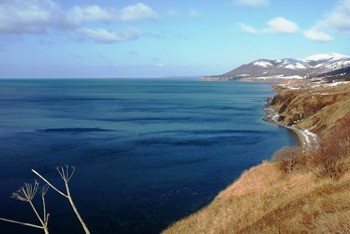
Description, what kind of fish is found, how to get there:
Terpeniya Bay is a bay of the Sea of Okhotsk off the southeastern coast of Sakhalin Island. In the eastern part it is partially limited by the Terpeniya Peninsula. The length of the bay is 65 km, width is about 130 km, depth is up to 50 m. The Poronai River flows into the bay. In winter the bay freezes. Fishing in the bay includes chum salmon, pink salmon, herring, smelt, and navaga.
GPS coordinates: 48.92781, 143.5725
Lake Tunaicha
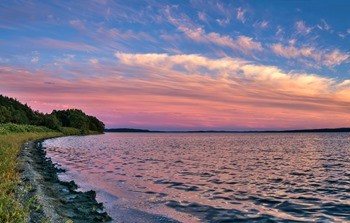
Description, what kind of fish is found, how to get there:
Tunaicha is the second largest lake in Sakhalin with a surface area of 174 km², located in the Korsakov region, in the north of the Muravyovskaya Lowland. Separated from Mordvinov Bay (Sea of Okhotsk) by the Puzina Peninsula, on which several smaller lakes are located. Connected to Mordvinov Bay by the Krasnoarmeyskaya channel. The lake is 29 km long and up to 6 km wide.The lake is home to fish: Sakhalin taimen, chum salmon, pink salmon, herring, smelt, navaga.
GPS coordinates: 46.76944, 143.225
RIVERS OF THE SAKHALIN REGION
There are more than 65 thousand different rivers in the Sakhalin region. Of course, most of them are quite small and do not even reach 10 kilometers in length. But there are also large rivers, for example, Poronai and Tym.
The vast majority of rivers in this area can be classified as salmon spawning reservoirs, where you can count on a good catch of pink salmon and chum salmon.
It should be noted that in the northern part of the island the rivers begin to become covered with ice already in the second half of November, and the ice melts only at the beginning of April.
In the southern regions the climate is more pleasant and water bodies freeze much later. In the middle of winter, the ice thickness can reach up to 90 centimeters, making fishing at this time almost impossible.
The most popular northern rivers for fishing:
- Kadylanyi.
- Piltun.
- Big.
- Lengeri.
- Pilvo.
In the central part you can go fishing on the banks of the following rivers:
- Pilenga.
- Bukzhlinka.
- Malaya Tym.
- Longari.
On the rivers, pike, Sakhalin rudd, Dolly Varden, kunja, coho salmon, chum salmon and taimen (which should be released) are caught all year round. Taimen in Sakhalin rivers reach gigantic sizes (two or more meters in length) and weigh up to thirty kilograms. Taimen lives not only in rivers, but also in low-salinity sea waters at river mouths and bays. But the largest and rarest fish in freshwater bodies is kaluga. It grows up to 5 meters in length and can weigh 1000 kg. This fish is listed in the Red Book of Russia.
In calm, large lowland rivers, the fisherman's prey will be grayling, carp, asp, lenok, Amur catfish, loach, bitterling, and topgazer. But these species do not form large populations and are not frequent prey.
Do you know any other good places for fishing in the Sakhalin region - write in the comments
